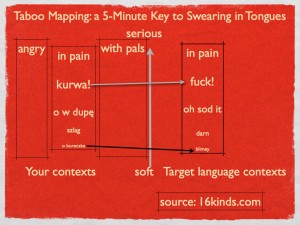
“Nonononono. You gotta put more tongue into it…”
It was beginning to work. Five minutes into a random conversation with two folks in a pub, we were already finding a common language, and it wasn’t English. After they’d left, I felt proud, but a bit puzzled. I taught these guys one of the most offensive words in one of the world’s hardest languages. The puzzling thing was: why do people care so much about these words?
I’ve thought about it long and hard. I have consulted masters and gurus. Now I know. And after reading this post, you will, too. Meet me after the jump.
Rule Number One: Do What Suits You, Not What Suits Others
I came back to thinking about swearing after a confusion caused by one man’s Powerpoint. The person in question admitted to swearing quite a lot, and asserted that it suits his “persona.”
This sentence was the missing key to my research into swearing. It explained everything. Most of all, it explained why so many of my students get the curse-words wrong when they learn English:
They’re trying to do things that don’t suit them at all.
Seventeen-year-old Slovenian girls using the “n-word” in class. Saudi gentlemen with their f-bombs. It all made sense: the words felt wrong, because they wouldn’t have used such a strong word in their own language in the first place!
For a learner, then, the taboo word issue must begin with a serious question: what kind of swear-words do you use in your own language? When and how often do you curse?
Rule Number Two: Taboo Mapping

This technique is the key to swearing successfully in any language. It’s so simple, even a child could do it (it would have to be a pretty outspoken child, though). All you need is pen and paper – it is also immensely helpful if you can access a native speaker of your target language for the third part of the exercise. Proceed as follows.
1. On the left-hand side of your chart, prepare several fields for general situations in which you find yourself swearing. Be thorough, but not fanciful: don’t hold back, and don’t invent unnecessary situations. Remember, it’s about your “persona.” Label each situation. These would be your “contexts.” Feel free to refer to the attached illustration.
2. In each context, try to find swear words you would normally use. List a few of them. IMPORTANT: write the less offensive ones at the bottom, and the more offensive ones at the top. Again, no need to be creative here: swearing is, after all, horribly conventional.
3. Once this is done, it’s time to do some mapping. This is what the right-hand side of your piece of paper is for. Here, it’s best to consult a native speaker (several, if possible – to get different insights). Explain to them what the contexts are. Ask what they would say in such situations. Again, it’s important that you grade their contributions: write the more serious curse words at the top, and the less serious ones at the bottom. It’s also useful here to ask your consultants how frequent the phrase is.
4. Decide on one or two phrases in each context. Learn them well. Practise in real-life situations: when cut off in traffic, when you’re angry at something – generally, when the context fits.
The results are stellar. To begin with, you’re learning swearwords by practicing them in the best possible moments. And since you’ve replaced your own cusswords with foreign ones, your demeanour and “persona” undergoes a curious change. The sentiment is still there (that guy can still show he’s angry), but the unpleasant reaction to a well-known phrase disappears.
Your swearing becomes sexier, smarter and loses that bitter aftertaste.
Thank me later.
Parting Volleys: Taboos And Consequences
Some words in your country would probably get you shot. Or at least fired.
My personal approach to swearing is that it’s an easy way out. Language is far more versatile than your f-bomb, and you should be able to do a lot better. But if you feel you need these words, be my guest.
The method described above works with sufficient good input, and can be applied using a beer mat and a lipstick. However, there are still situations when taboo words are uncalled for, frowned upon or simply forbidden.
If you haven’t done your homework about these situations, leave these incendiary phrases aside and keep learning. A time will come when they will just feel right; but if you’re feeling awkward about using them, that’s an instinct you should probably trust.
Resources: The Theory of Swearing
For more on how and why people swear, I recommend two videos by Steven Pinker. Prepare to be amused by a linguist (when was the last time that happened?)
“Fry’s Planet Word” also had an episode on swearing, inspired to a large extent by Pinker.
Wiktor (Vic) Kostrzewski (MA, DELTA) is an author, translator, editor and project manage based in London. When he works, he thinks about languages, education, books, EdTech and teachers. When he doesn’t work, he probably trains for his next triathlon or drinks his next coffee.
BRAVE Learning (formerly known as 16 Kinds) is a lifelong learning and productivity blog. If you enjoy these posts, please check out one of my books and courses.
My recent publications, and my archive, is now all available on my new project: PUNK LEARNING. Hope to see you there!


One reply on “Taboo 101: A Five Minute Guide to Swearing in Any Language”
[…] a lot less formal than you expected. There’s nothing you can do about the shirt and tie, and swear words are out of the question. Still, you manage a slightly different intonation and choose a few […]